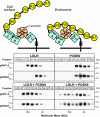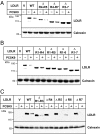Structural requirements for PCSK9-mediated degradation of the low-density lipoprotein receptor
- PMID: 18753623
- PMCID: PMC2526098
- DOI: 10.1073/pnas.0806312105
Structural requirements for PCSK9-mediated degradation of the low-density lipoprotein receptor
Abstract
Proprotein convertase subtilisin/kexin type 9 (PCSK9) is a secreted protein that controls plasma LDL cholesterol levels by posttranslational regulation of the LDL receptor (LDLR). Previously, we showed that PCSK9 binds specifically to an EGF-like repeat (EGF-A) in LDLR and reroutes the receptor from endosomes to lysosomes rather than to the cell surface. Here, we defined the regions in LDLR and PCSK9 that are required for receptor degradation and examined the relationship between PCSK9 binding and LDLR conformation. Addition of PCSK9 to cultured hepatocytes promoted degradation of WT LDLR and of receptors lacking up to four ligand binding domains, EGF-B or the clustered O-linked sugar region. In contrast, LDLRs lacking the entire ligand binding domain or the beta-propeller domain failed to be degraded, although they bound and internalized PCSK9. Using gel filtration chromatography, we assessed the effects of PCSK9 binding on an acid-dependent conformational change that happens in the extracellular domain of the LDLR. Although PCSK9 prevented the reduction in hydrodynamic radius of the receptor that occurs at a reduced pH, the effect was not sufficient for LDLR degradation. A truncated version of PCSK9 containing the prodomain and the catalytic domain, but not the C-terminal domain, bound the receptor but did not stimulate LDLR degradation. Thus, domains in both the LDLR and PCSK9 that are not required for binding (or internalization) are essential for PCSK9-mediated degradation of the LDLR.
Conflict of interest statement
The authors declare no conflict of interest.
Figures






References
-
- Goldstein J, Hobbs H, Brown M, Scriver C, Beaudet A, Sly W, Valle D. The Metabolic and Molecular Bases of Inherited Disease. New York: McGraw Hill; 2001. pp. 2863–2913.
-
- Innerarity TL, et al. Familial defective apolipoprotein B-100: A mutation of apolipoprotein B that causes hypercholesterolemia. J Lipid Res. 1990;31:1337–1349. - PubMed
-
- Garcia CK, et al. Autosomal recessive hypercholesterolemia caused by mutations in a putative LDL receptor adaptor protein. Science. 2001;292:1394–1398. - PubMed
-
- Abifadel M, et al. Mutations in PCSK9 cause autosomal dominant hypercholesterolemia. Nat Genet. 2003;34:154–156. - PubMed
Publication types
MeSH terms
Substances
Grants and funding
LinkOut - more resources
Full Text Sources
Other Literature Sources
Molecular Biology Databases
Miscellaneous

